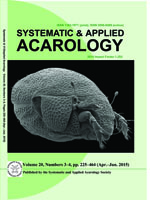Many studies have shown that the composition of invertebrate communities in soil changes under the influence of stressors in the soil ecosystem. Conversely, an observed altered community structure may be indicative of stress. In this study we aimed to investigate responses of oribatid mite communities to heavy metal (zinc, copper and cadmium) contamination of grasslands nearby a lead and zinc smelting plant at Zanjan, Iran. Soil analysis showed that the Zanjan plant is a major source of zinc and cadmium in the area. No relationship could be found between metal pollution and total density of oribatids, but the number of species and the Shannon diversity index were lowest in the sites polluted by zinc and cadmium. Species diversity was significantly negatively correlated with zinc and cadmium, but not with copper concentrations. Oribatula (Zygoribatula) connexa connexaBerlese, 1904, was a dominant species at all sites; the percentage dominance of this species was highest at the most polluted site. Our survey confirms that oribatid mite communities display a great variety of responses to heavy metals, depending on the species.
How to translate text using browser tools
17 April 2015
Oribatid mite communities in contaminated soils nearby a lead and zinc smelting plant in Zanjan, Iran
Maryam Keshavarz Jamshidian,
Alireza Saboori,
Mohammad Ali Akrami,
Nico M. Van Straalen
ACCESS THE FULL ARTICLE

Systematic and Applied Acarology
Vol. 20 • No. 3
April 2015
Vol. 20 • No. 3
April 2015
diversity
heavy metals
oribatid mites
Oribatula
smelting plant
soil pollution




